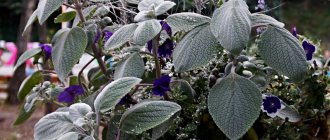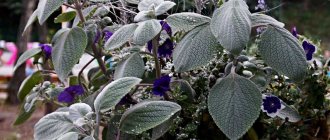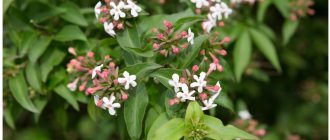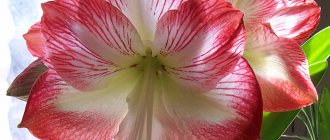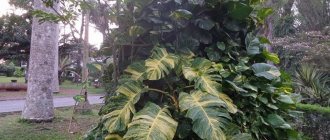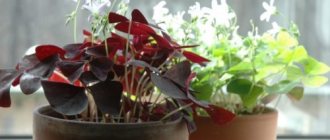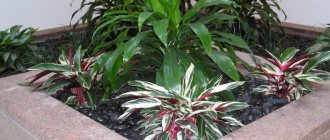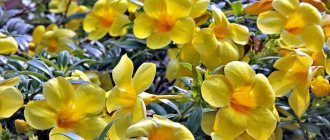Plectranthus grows in the wild on open slopes and meadows in tropical or subtropical climate zones. The evergreen herbaceous or shrubby plant has at least 250 species. In Russia, in the southern territories of the Far East, of these representatives of the family Lamiaceae (Lamiaceae), only spur flowers (as plectranthus are called for the peculiarities of their flower shape) are found: serrated, notched and bluish-cupped.
Plectranthus has won the love of gardeners in indoor culture due to its thick carved greenery, variety of shapes and shades, and unpretentiousness. Housewives value the plant not only for its decorative value. The leaves and flowers of plectranthus emit a light aroma reminiscent of mint and lavender, which repel moths and other harmful insects. For this feature, the flower is popularly nicknamed flyhog.
Priming
For successful growth of a crop, fertile, loose, well-permeable soil is needed. The soil should have a slightly acidic pH of 6.2 to 7.2. A universal soil mixture works well.
When preparing it yourself, it is recommended to take 2 parts humus, 3 parts turf soil, 2 sand, 100 g bone meal, 20 g superphosphate.
When planting, a drainage layer (expanded clay, pieces of polystyrene) should be poured onto the bottom of the pot one-third of its height.
Spicy and medicinal herbs whose leaves smell like citrus
Melissa officinalis
Grown in Europe and North America . A perennial herbaceous plant with oval leaves with toothed ends and a relief structure. The inflorescence consists of several small corollas with white or bluish petals.
- Preparations based on lemon balm have a pronounced sedative effect. They help treat insomnia, relieve spasms, and have choleretic, diuretic and healing effects.
- Tea lowers blood pressure and soothes inflamed mucous membranes of the gastrointestinal tract.
Consuming lemon balm is beneficial for women's health:
- normalizes the menstrual cycle;
- relieves inflammation of the appendages;
- during pregnancy it alleviates toxicosis.
We invite you to watch a video about lemon balm:
Cat mint
Distributed in central Russia, Southern and Central Europe, the North Caucasus, the Far East and the USA.
The plant is about one meter high and has a woody stem with carved heart-shaped leaves; the inflorescence consists of small petals of a white or lilac hue.
Cat mint:
- treats insomnia;
- calms the nerves;
- facilitates the removal of mucus during bronchitis;
- relieves spasms of the brain and intestines;
- causes appetite.
The plant is used in the veterinary field , to prevent the appearance of worms in animals, and also as a sedative for cats.
We invite you to watch a video about catnip:
Moldavian snakehead
It grows in most of Eurasia and North America in temperate climates. A herbaceous plant with small elongated leaves with serrated edges. The purple flowers form a racemose inflorescence . The snakehead grows up to 80 centimeters.
Plant:
- Can help with neuralgia, headaches and toothaches.
- Improves digestion.
- Increases immunity.
- Has a choleretic effect.
- has an antiseptic effect.
- Heals wounds and relieves inflammation.
We invite you to watch a video about the Moldavian snakehead:
Lemon Basil (Ocimum x citriodorum)
Originated from Central and South Asia and spread throughout the world. Plant up to 50 centimeters high. A strong branched stem with many small, rough, oblong leaves. The flowers are produced at the top of the branch and are white or pale pink in color.
Used for gastrointestinal and bladder diseases, flatulence and bloating.
Lemon verbena (Aloysia citriodora, Aloysia triphylla)
It grows on almost all continents, but South America is considered its homeland. A lush plant with narrow arched leaves. It blooms in small inflorescences of a light purple hue (reminiscent of a lilac branch). Has a pronounced lemon smell.
Verbena:
- treats diseases of the digestive tract;
- calms the nervous system;
- tones the body;
- improves mood.
It is a real salvation for skin rashes, evens out complexion and rejuvenates.
We invite you to watch a video about lemon verbena:
Lemon thyme (Thymus x citriodorus)
Grown in the temperate climate of the northern hemisphere. Perennial plant, up to 30 centimeters high .
The leaves are round and small, dark green in the middle and with a pale green tint at the edges. The flowers are lilac.
- In medicine, the plant has proven effective in treating respiratory diseases.
- Inhibits the development of pathogenic microflora.
- Normalizes the production of gastric juice.
- Strengthens heart health.
- Helps improve sleep.
We invite you to watch a video about lemon thyme:
Lemon savory
Distributed on all continents, native to the Mediterranean. A perennial with creeping shoots and narrow elongated bright green leaves. The pink or purple flowers emit a concentrated lemon scent .
Used as an antibacterial and anthelmintic agent. Helps cope:
- with headache;
- tachycardia;
- cystitis;
- with gastrointestinal diseases.
Lemongrass
Grows in India, Thailand, China, Africa and America. An evergreen perennial plant that looks like a tuft of grass . In tropical climates it can reach 1.8 meters in height.
- Lemongrass normalizes the functioning of the digestive system.
- Effective for headaches, skin rashes, rheumatism.
- Increases the tone and performance of the body, helps fight colds.
- Reduces oily hair, removes toxins, burns cellulite.
Lemmon's marigolds
Lemon marigold is a perennial herbaceous plant up to 120 centimeters tall with narrow long leaves 5-15 centimeters long. The small yellow flowers exude an amazing aroma, a mixture of citrus, mint and a subtle hint of camphor. The plant's homeland is called the USA and Mexico .
Marigold oil has antimicrobial, antifungal, antispasmodic and sedative properties.
Pot
The size of the pot depends on the amount of mint you are growing. A container with a diameter of 14 cm is suitable for one bush. Up to 5 plants can be grown in a container with a diameter of 32 cm.
Indoor flowers with lemon scent: names, descriptions and photos
Geranium (Pelargonium graveolens)
A plant with small pink or purple flowers. The leaves are carved, reminiscent of grapes, covered with tiny fibers on both sides. The plant can reach a height of over one meter.
Geranium has antiseptic properties, kills bacteria in the air and absorbs odors, which is why this plant has found a place in the kitchen.
It has a calming effect and is widely used in aromatherapy.
We invite you to watch a video about fragrant geranium:
Murraya
An evergreen tree reaching a height of 1.5 meters at home. The leaves are dark green in color with a distinct citrus flavor and smell. A distinctive feature of the plant is the simultaneous appearance of delicate white flowers of small size and red elongated berries, similar in appearance to rose hips.
- Phytoncides contained in the leaves purify polluted air, help treat headaches and cardiovascular diseases: hypertension, angina pectoris and more.
- Microelements improve mood and stimulate mental activity.
- Murray berries, sweetish in taste, improve tone and are used to prevent the body from fading.
We invite you to watch a video about the muraya plant:
Plectranthus aromaticum or spur flower
A perennial herbaceous plant with fleshy, rounded leaves covered with hairs. White, lilac and violet bell-shaped flowers of the spur flower are collected in multi-flowered inflorescences. At home it reaches 80 centimeters in height .
If you break the plant, you can smell a strong mint-lemon aroma.
Medicinal infusions from aromatic plectranthus:
- have anti-inflammatory and analgesic effects;
- have a moderate laxative effect;
- help with heartburn and gastritis;
- improve appetite;
- relieve rheumatism.
Lighting and location
Culture loves diffused lighting. Direct sunlight is contraindicated (causes burns and discoloration of leaves). Daylight hours are at least 9 hours. This is especially necessary for variegated varieties. For illumination in winter when daylight hours are short, it is recommended to use fluorescent lamps. To avoid stretching of shoots, the plant should not be placed in a dark place.
Plectranthus should be placed on the window sills of the southwestern or eastern part of the room, where there is soft, diffused light. When located on the south side, protection from direct sunlight is necessary.
Plectranthus: reproduction
All varieties are most easily propagated by cuttings. After pinching off a piece of at least 10 cm, it is placed in water for several days. To activate the process and obtain a more developed, strong root system, a root formation stimulator (Heteroauxin, Kornevin) is added to the water. You can plant cuttings when the roots have grown 5-10 mm. The survival rate of Plectranthus is very high.
When transplanting into new containers, adult indoor mint bushes are divided if too many shoots have grown from the root. The plant is completely freed from the soil and the root system is washed. Cut into pieces with a sharp knife. It is necessary to divide it so that each new bush has strong, healthy roots and several shoots.
Trimming
Before intensive growth begins, the crown of the plant must be carefully trimmed. This will cause side shoots to grow.
Before the procedure, the pruning shears must be treated with alcohol, as the stem may be damaged (rotting will occur).
First of all, when pruning, you need to remove injured and weak branches. It is recommended to cut them to 2/3 of the length. There is no need to worry, as the cut shoots will quickly put out buds and begin to grow.
In ampelous crops, to enhance growth, you should lightly pinch the tips.
Since shrubby species grow quickly, they can be grown in the form of a ball. In this case, the lower leaves should be torn off, and the upper shoots should only be pinched.
To avoid rotting, it is best to sprinkle the cut area with charcoal powder, which has drying and antiseptic properties.
Plectranthus care
Many types of spur flowers, for example, the southern one, are so unpretentious that they are often grown in the halls and corridors of educational institutions and office complexes. There is usually enough light in such rooms; only regular watering and fertilization are required several times a year. For caring housewives, caring for plectranthus also means plant formation and replanting.
Watering
Tropical plants are moisture-loving. They are watered with warm, settled water as soon as the top layer of soil (per phalanx of the finger) has dried. This is the soil moisture regime in summer, during the growing season. In winter, water less frequently and less abundantly. To determine whether it is time to water the plectranthus, make sure that the soil is dry 1-2 cm deep and wait a couple more days.
Feeding
The plectranthus flower is fed no more than 2 times a month during the growing season with a universal complex for decorative foliage plants. Alternating mineral compositions and organics will give the greatest effect. The first application of fertilizer is in the spring, when the plant begins a new active cycle after winter.
Trimming, pinching
Bush and cascade forms of plectranthus are cut to half their length every spring, before active growth begins. This stimulates the greatest tillering. Weak shoots that have become too elongated during the winter, reducing the decorative value of the plant, are cut out completely or shortened. Spurflower easily tolerates pruning at any time of the year. To correct the shape, do this as needed.
In the summer, while plectranthus grows new shoots, it is periodically pinched to thicken the green cover. This is especially important for hanging varieties.
Transfer
Young plectranthus are replanted annually in the spring until the age of five. An actively developing plant requires changing the container to a larger size and updating the nutrient soil. Adult flowers mature once every 2-3 years.
The root system of spur flowers is well developed, so a high capacity is selected. Expanded clay or other drainage material (3-4 cm) is laid on the bottom. Plectranthus easily tolerates changing the pot and soil, but for the first 2-3 days after the procedure it stands in deep shade. This is important for the adaptation of the root system.
Transfer
Due to rapid growth, the crop must be replanted annually. The container should be 3cm larger than the root ball. In this case, it is important to inspect the root part for the absence of diseases, pests and damage.
After four years, the plant must be replanted every two years. Transplantation is best done in the spring before rapid growth begins.
What are the benefits of indoor mint?
The benefits of mint plectranthus when used extend to many body systems. Infusions and decoctions based on spur flowers:
- relieve inflammation of the mouth and throat;
- eliminate itching and skin irritation;
- have a diuretic effect and relieve swelling;
- have sedative properties and have a beneficial effect on the nervous system;
- relieve anxiety and depression;
- have a fixing effect on diarrhea;
- promote the removal of helminths from the intestines;
- strengthen immune resistance and prevent colds;
- improve expectoration during cough and bronchitis;
- have an antibacterial effect.
We recommend reading: Lovage: beneficial properties, contraindications for women and men
Externally, products based on indoor mint are used for irritations, allergic rashes, wounds and insect bites. Decoctions and infusions fight inflammation and help restore the skin.
Attention! Indoor mint is popular in cooking. It is added to soups and salads, liqueurs and syrups, and sweet desserts.
Growth periods (rest, flowering)
By nature, plectranthus does not need a period of rest. But you can create peace yourself. To do this, in winter you need to reduce watering and stop feeding.
Flowering usually occurs in summer. At this time, small inflorescences appear in the form of spikelets. Since flowers take a lot of energy from the crop, it is recommended to prune them.
Possible problems during cultivation
Violation of the growing rules can lead to the fact that indoor mint begins to wither and weaken. Most often, the reasons are insufficient watering or improper lighting.
Why do plectranthus leaves turn yellow and what to do?
The most common unpleasant symptom when growing indoor mint is yellowing of the leaves. Among the reasons are:
- air temperature is too low;
- drying out of the soil in the pot;
- growing plectranthus in direct sun.
To keep the leaves of plectranthus green and juicy, you need to keep the soil in the pot constantly moist and make sure that the plant does not freeze in drafts. The lighting should be bright, but diffused - direct rays can cause burns to the leaves.
Fatigue
Sometimes the scent of mint is all you need to perk you up because it is a natural stimulant. The smell of mint helps cope with stress, relax the body and calm the mind, and also promotes the production of serotonin in the body. So the next time you need a pick-me-up, fill your bathtub with warm water and add mint leaves.
Shrubs
Wormwood "God's Tree" (Artemisia abrotanum)
Widely distributed throughout Russia, the European part, Siberia and the North Caucasus. Perennial subshrub, up to 150 centimeters high. The leaves are bluish-green, pressed underneath, covered with gray down. Small yellow flowers in small, drooping baskets are collected at the top of the stem and form a spreading paniculate inflorescence.
Decoctions of wormwood leaves are used for:
- colds, flu, sore throat;
- rheumatism;
- toothache, gum inflammation;
- menstrual irregularities;
- as a choleretic agent;
- to strengthen hair.
We invite you to watch a video about wormwood:
Callistemon lemon
Mostly distributed in Australia, in Russia it is grown at home. In the wild, the bush reaches 3 meters in height , has green, linear-lanceolate leaves, sharp at the top, up to 9 cm long and 1 cm wide. Flowers of unusual shape, reminiscent of “kitchen brushes” in red or pink. The leaves exude a bright lemon aroma.
Callistemon lemon has antibacterial properties and can disinfect indoor air.
We invite you to watch a video about Callistemon lemon:
Most plants, herbs and flowers that smell of lemon not only perfectly imitate the citrus smell, but are also a source of valuable natural trace elements. Their correct use will give a person beauty and health for a long time.
Application
The plant uses leaves and stems, both fresh and dried. When fresh, they are often found in pickled and canned vegetables and fruits, thanks to which the preparations receive a pleasant aroma.
Lemon balm can be added to many sauces for meat, fish dishes and various salads.
But its most famous use is, of course, tea, which will not only perfectly quench thirst, but will also help stimulate appetite and improve the functioning of the gastrointestinal tract.
Essential oils are made from it, which are successfully used in perfumery and cosmetology, as well as to improve the taste of dishes and flavor alcohol.
Asthma
Since mint helps clear the airways, regular use is ideal for those suffering from asthma. Asthmatics are advised to add mint to their inhalations and drink mint tea. To instantly ease your breathing, add 4-5 mint leaves to hot water and inhale.
Mint contains rosmarinic acid, which acts as a powerful antioxidant that helps with allergies.
How to grow mint and lemon balm on a windowsill - the secrets of a good harvest
A useful article is a review of how mint grows on a windowsill, as well as its relative, the herb lemon balm. Secrets of planting, care, selection of seeds, watering, harvesting.
Mint and lemon balm are very common and beloved spicy aromatic plants by everyone without exception.
Many people know about their most valuable healing properties and use these gifts of nature for the benefit of their health.
Melissa and mint on the windowsill - how to grow and always have fresh spice at hand all year round? This will be discussed below.

